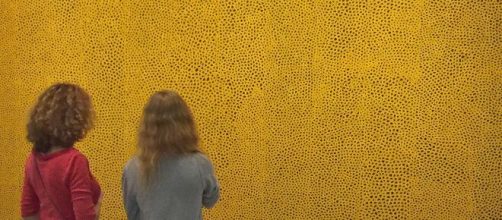Ho-hum, another abstract art show at MoMA with the usual suspects - Kandinsky, De Kooning, Dubuffet…but wait, this show isn't that.
Big difference
The show title Degree Zero doesn't make much of its distinguishing characteristic. But it's a biggie. You don't only get the superstars of the abstract art movement - the Americans and Western Europeans who made a splash with imagery free of recognizable anything. You get artists from Africa and Asia, too.
Who knew that the impetus for this modern art movement was felt worldwide, that diverse artists around the globe had the same need to forge a new visual language beginning in 1948?
The tie that binds was likely the end of a devastating world war.
The pheromones
All of which sounds like pheromones at work. You know about them, right? They're the reason that, say, in a workplace, you see several people wearing the same color. When I worked in a newsroom, I'd notice the color of several fellow reporters' shirts like mine. Coincidence?
Pheromones, according to the Smithsonian Magazine, are airborne compounds that send signals about states of mind. This is what must have occurred with artists who turned to abstraction globally.
Another big takeaway from MoMA's abstract drawing shows that they're not undisciplined despite the freedom from recognizable anything. In each of the 80 drawings on exhibition, you get a clear impression of organized chaos - so composed that it borders on decoration.
Whether scrawled or hard-edged, you see efforts to control the mayhem around us.
Small world
Jonathan Goodman writing about the MoMA show for White Hot Magazine, saw it as an "appreciation of form for its own sake." Yes, there's that, but there's something else, and he took note of it: how the range of abstract art-makers extends beyond the shores of America and Europe. He rightly called the modern movement an "international language that joined people from different, far away cultures."
Goodman recognized something else key to this show. Because the imagery is so free, unencumbered by representation, you see the artists' joy at being free along with the discipline that artmaking requires. Consider the drawing called Infinity Nets by Yayoi Kusama of Japan made in 1951.
She has since done a ton of these in an ongoing series.
At MoMA, what you see in Kusama's exhibit example are columns of minuscule squares linked up as they move down the picture plane. And with plenty of room on either side of the lineup, the squares look crowded, even squashed.
One can only imagine how intense her effort had to be to draw such tiny boxes over and over. Yet, you sense Kusama's joy at the freedom from having to represent the visible world.
Kandinsky said it better than I when he wrote in his essay Concerning the Spiritual in Art: the more abstract a work, the clearer and direct its appeal. "To deprive oneself of this possibility is to limit one's power of expression."
Silly justification
But Kandinsky went too far when he added that an acute angle of a triangle meeting a circle is not less powerful than Michelangelo's image of the finger of God touching Adam's finger.
Hyperbole like that is not necessary to rationalize abstract art. It's enough to say that the need in the '50s to organize the madness after a horrible war and freshly see things is plenty understandable. No more justification is needed than that.


